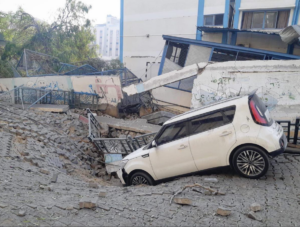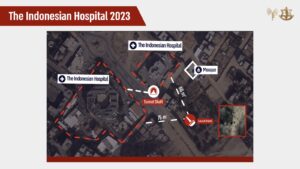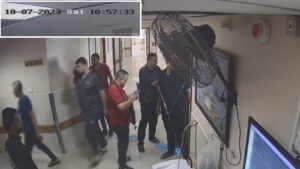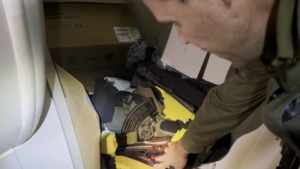[Editor’s Note: This is Part One of what will be a five-part series addressing flaws in a number of CNN “investigations” into allegations against Israel.]
Good investigative journalism is journalism at its best. In an era in which many media outlets simply serve as amplifiers of social media posts, press releases, and partisan cliches, curious and professional journalists truly devoted to uncovering the truth are all the more important.
Unfortunately, that kind of good journalism is all too often missing at CNN. Rather than producing impartial, professional investigations, many of the network’s journalists are acting as one-sided prosecutors when it comes to Israel.
CAMERA has raised some of these issues in regard to past CNN “investigations,” including those relating to the death of Shireen Abu Akleh, the February violence in Huwara, and the IDF’s presentation of terrorist weapons at al-Shifa Hospital. More recently, the network has put out two more deeply flawed investigations of Israel, including one regarding the munitions the IDF is using in Gaza and one regarding IDF operations at Kamal Adwan Hospital.
The consistent bias and flaws found in these investigations fall into five general categories: (1) omitting exculpatory evidence; (2) ignoring questions of credibility; (3) presenting one-sided and dubious “expert” analysis; (4) excessively using skewed context and language to mask shortage of evidence; and (5) demonstrating a partisan agenda.
Below is an analysis of the first flaw. There will be analyses of how each of the other four categories plague CNN’s investigations in forthcoming articles, as well.
Ignoring or Omitting Exculpatory Evidence and Context
The most glaring problem with CNN’s investigations is the disinterest shown toward evidence that contradicts the central allegations. Such behavior is to be expected of prosecutors or spokespersons, who seek to present a certain narrative. It is not appropriate for anyone trusted to impartially present the information necessary for the public to understand the issues for themselves.
As has been explained in journalistic codes of ethics and principles, one of the “cornerstones of truthfulness” is “not leaving important things out.” Even prosecutors are obliged by the rules to disclose material, exculpatory information in their possession. Yet, time and again, CNN’s attempts to investigate, or create, allegations against Israel leave the important, exculpatory information out.
- The Munitions Investigation
Perhaps the clearest illustration of this comes from CNN’s 12/22 investigation into the use of certain munitions by Israel, authored by Tamara Qiblawi, Allegra Goodwin, Gianluca Mezzofiore, and Nima Elbagir.
The main allegation is that the IDF has been using large numbers of 2,000-pound bombs which cause fragmentation that is “capable of killing or wounding people more than 1,000 feet away.” These heavy munitions, it is claimed, are responsible “for the soaring death toll.”
But the article never actually connects the use of these bombs with substantial numbers of deaths. The only way it can charge that is by omitting, or in one case hiding in small text, details that undermine the entire allegation.
The most significant detail the authors glossed over is explained in a subsequent statement by the Israeli Air Force Chief of Staff: “Heavy munitions are detonated underground, preventing fragmentation and significantly reducing the blast wave and debris as a result.”
As pointed out by Lenny Ben-David at the Jerusalem Center for Public Affairs, CNN appears to be using data on general-use MK-84 bombs, which explode aboveground, to make the claim about the large fragmentation radius.
And it’s perfectly clear that the authors knew the bombs were not being detonated aboveground. In the main text of the article, the second sentence says that the “500 impact craters” it analyzed are “consistent with those left behind by 2,000-pound bombs.” But hidden in small text in an image caption, the authors quietly add an important detail: the craters are “consistent with underground explosions produced by 2,000-pound bombs.”
Realize what the authors did. They deceptively combined data for fragmentation radiuses for a munition exploding aboveground with the number of craters consistent with that munition exploding underground in order to imply that those craters were caused by bombs sending lethal fragmentation as far as 1,000 feet away and killing large numbers of Palestinian civilians.
The apparent deception is jaw-dropping in its level of dishonesty.
Consider two of the specific examples given in the article, neither of which actually demonstrate the authors’ main claim.
One example given is a 10/24 airstrike “about 328 ft” away from the Wafa Hospital. CNN tells the audience that the crater was “consistent with 2,000-pound bombs,” and writes about how “terrified the patients and medics” were. But the article itself admits that even though the hospital was within the 365 foot “lethal fragmentation radius,” it is “unclear whether the October 24 blast caused significant damage to the hospital.” In other words, they show evidence Israel used a 2,000-pound bomb, but they don’t have evidence it actually caused any harm to civilians nearby.
The other example given is a 10/31 airstrike that targeted Hamas commander Ibrahim Biari in his command compound in Jabaliya camp. The article tells readers that the bombing killed over 100 Gazans “and caused catastrophic damage in the densely populated area.”

An image, posted originally by UNRWA, showing what appears to be a sinkhole next to its facility, possibly caused by the collapsing of a tunnel underneath.
But the story omits a critical detail: much of the damage wasn’t directly caused by the munitions. Rather, it was the collapse of the tunnel network in the area minutes later which brought down nearby buildings. It seems that many, if not most, of the victims weren’t killed by the bomb’s “lethal fragmentation radius” – which is the central allegation of the article – but rather the collapse of tunnels Palestinian terrorists built underneath their homes.
The party thus responsible for the danger to civilians in the area wasn’t the IDF, but rather Hamas, which built terror tunnels underneath civilian infrastructure. As the U.S. Department of Defense Law of War Manual states, “The party that employs human shields in an attempt to shield military objectives from attack assumes responsibility for their injury…” Of course, the attacking party must still take feasible precautions – which the IDF appears to have done by detonating the explosives underground – but CNN’s investigation did not even address that question.
This leads to the broader issue that is regularly omitted in CNN articles: the context within which the IDF is operating. As explained, both legally and morally, the party using human shields is responsible for the injury of those civilians. Yet CNN’s investigations gloss over this. At most, the reporters include a bland statement from the IDF and leave it at that, as if they don’t have a journalistic responsibility to look into the full story themselves.
As explained in 2021 by two experts on the law of armed conflict, LTC (ret.) Geoffrey S. Corn and Lt. Col. (ret.) Rachel E. VanLandingham:
Israeli attacks may cause damage and destruction, but the responsibility for the tragic impact on Gaza civilians belongs exclusively to Hamas. This is because the terror organization pervasively and illegally exploits the presence of civilians to shield its targets and complicate IDF attack decisions. And Hamas knows that no matter the attack decision the IDF makes, it wins: If the IDF exercises restraint, Hamas wins a tactical benefit, but if the IDF launches the attack, Hamas wins a strategic information benefit by exploiting the attack’s collateral civilian impact.
By failing to do their journalistic responsibility, the authors are, willingly or unwillingly, serving as accomplices to Hamas’s cynical media strategy.
- The Kamal Adwan Hospital Investigation
The next example comes from CNN’s 12/23 article, “Doctors accuse Israeli troops of desecrating bodies and shooting civilians at hospital Israel says was Hamas ‘command center,’” authored by Abeer Salman and Kareem Khadder. The authors accuse Israel of a number of horrific sins, from bulldozing corpses to cruelly laughing while shooting innocent doctors.
For purposes of this piece, we’ll focus mainly on the claim that Israeli forces “used bulldozers to dig up bodies that had recently been buried in makeshift graveyards in the hospital’s courtyard,” thus “desecrating” them.
The article cites witness testimony, satellite imagery, and a video for the claim that the grounds were dug up. But none of the referenced evidence deals with a central question in all military operations: why might Israel have done this? By omitting any examination of this central question, the authors leave the readers with the impression that the IDF is just needlessly cruel.
Readers are thus left without the information that there is plenty of evidence that Hamas has exploited burial grounds for military purposes. Rocket launchers have been discovered in them, both above and below ground. In fact, the infamous explosion at al-Ahli Hospital was caused by an Islamic Jihad rocket fired from a cemetery.
Also omitted is that the IDF has been looking for the bodies of Israeli citizens taken hostage by Hamas and other Palestinian terrorists. Indeed, we know that at least two bodies of Israeli hostages were found next to al-Shifa Hospital, including Yehudit Weiss and Noa Marciano, the latter of whom was apparently executed there.
Hamas isn’t even above booby-trapping dead bodies to try and kill Israelis.
These are plausible, legitimate explanations for why the Israeli forces might have dug there. Why couldn’t the investigation have considered these details?
Another example of omitting important information is when the article tries to cast doubt on Israel’s justification for operating at the hospital. After explaining that hospitals “may be viewed as legitimate military targets if found to be housing able-bodied combatants and weapons,” the article cites language from one of the Geneva Conventions for the proposition that “presence of small arms and ammunition taken from such combatants which have not yet been handed to the proper service, shall not be considered to be acts harmful to the enemy.”
But, contrary to what is being implied, the IDF has repeatedly made clear its reason for operating at hospitals is much more than to just find “small arms and ammunition.” Rather, it has clearly indicated it believes the hospitals have been used as Hamas staging grounds and command centers, not just hosting terrorists and terrorist leaders, but even being used as detention facilities for Israeli hostages. Such a use would make these hospitals enormously significant military objectives.

An infographic from the IDF detailing the location of a tunnel shaft and rocket launchers next to the Indonesian Hospital in Gaza.
The evidence supporting the IDF’s belief is overwhelming, too, and comes from many sources. Multiple Western journalists have reported seeing it for themselves throughout multiple conflicts. The United States has said it has strong evidence, acquired independently of Israel, that Hamas uses hospitals, and has since independently confirmed that Hamas used al-Shifa Hospital as a command center. Israel has shown clear footage, entirely capable of being geolocated and verified, of tunnels on the grounds of multiple hospitals, including al-Shifa Hospital (see also here, here and here), the Sheikh Hamad Hospital, the Indonesian Hospital, and al-Rantisi Hospital. Hamas themselves published footage of its terrorists at al-Rantisi Hospital. The IDF has shown aerial footage of a terrorist with an RPG using al-Quds Hospital for cover and of terrorists firing from the Sheikh Hamad Hospital. In addition to the CCTV footage from al-Shifa Hospital – showing armed terrorists dragging hostages inside – at least one freed hostage has said she and one other hostage were held in a hospital.

A still from CCTV footage from al-Shifa Hospital on October 7, 2023, showing armed terrorists inside after bringing two hostages inside.
The story of hospitals in Gaza is a highly charged one. Salman and Khadder owe it to their readers – who deserve the facts necessary to judge for themselves – to give them all of the important details, not just those that portray the IDF in a negative light. To do otherwise is to, once again, play into the cynical and malicious media strategy of a terrorist organization that is counting on journalists not telling the whole story.
- The Shifa Hospital Investigation
Perhaps CNN’s most absurd investigation came on November 18, when the network’s Katie Polglase and Gianluca Mezzofiore suggested that the IDF might have planted weapons at al-Shifa Hospital before bringing in foreign journalists to tour the building and see for themselves Hamas’s exploitation of the hospital.
The evidence for Polglase and Mezzofiore’s claim? That two videos – one featuring an IDF spokesperson and the second featuring a Fox News correspondent in the same area several hours later – showed a different number of weapons next to an MRI machine.
It’s almost impossible to overstate how inane the article was.

IDF Spokesperson Col. Conricus showing a bag with weapons inside behind an MRI machine at al-Shifa hospital.
Omitted entirely was the obvious explanation for the discrepancy that was made clear in the earlier video, which featured IDF Spokesperson Jonathan Conricus touring the hospital. While showing the weapons and terrorist equipment inside the hospital, Conricus explains that the IDF was still in the process of searching the premises and that they were opening containers and moving items around to ensure safety. Indeed, at one point, the spokesperson even clearly stated: “And again, we opened it up in order to make sure that it’s safe to touch and show. So please don’t give me any of that ‘you opened it up and you placed it there.’”
Sure enough, comparing the two videos, one can see that more bags and boxes had been opened up and moved around, including by the MRI machine, by the time the Fox News correspondent arrived. It was, after all, still an active combat zone, and Hamas is known to booby-trap buildings, including health centers. In 2014, three IDF soldiers were killed by a booby-trap in an UNRWA health clinic.
In this case, it’s not that the reporters could not have known: the explanation was given in one of the videos reported on. Mezzofiore and Polglase deceptively omitted Conricus’s explanation and then pretended it was a mystery – or a conspiracy – why the scene looked different. Omitting that explanation seems to serve no other purpose than to try and tarnish the IDF’s credibility.
- The Abu Akleh Investigation
After the death of Shireen Abu Akleh during an IDF counterterror operation in Jenin, CNN published an “investigation” that sought to prove not just that the bullet that killed her came from the IDF, but that the IDF targeted her. The May 2022 article was authored by Zeena Saifi, Eliza Mackintosh, Celine Alkhaldi, Kareem Khadder, Katie Polglase, Gianluca Mezzofiore, and Abeer Salman.
The investigation omitted numerous details necessary to assess the accuracy of many of its claims and assumptions. Chief among the details omitted is information about the central piece of evidence upon which almost all of the article was built: the expert analysis of audio of the gunfire.
The network turned to Professor Robert Maher, who, in examining the audio, said that the gunfire came from “177 and 197 meters” away. Multiple other pieces of evidence are then built on this foundation to suggest the IDF targeted Abu Akleh. The article claims that the IDF was approximately at that distance, that Palestinian terrorists could not have been responsible because they were more than 200 meters away, and that the tight spread of bullet holes in a tree nearby Abu Akleh proves it was not a random spread of gunfire from that far away.
But what the authors omit are important caveats and assumptions that came with the analysis. As Maher had explained elsewhere:
“Maher added a note of caution and caveats to these calculations. ‘The estimate of the distance depends upon the air temperature, since this affects the speed of sound’ he said.
While the calibre of bullet analysed is also consistent with reports that the bullet which killed Abu Akleh was 5.56mm, it is also important to note that this calculation does not account for the possibility that another weapon not visible or captured in videos from the scene could have been used.
On top of this, Maher noted that even a slight difference in the assumed speed of the bullet could result in change to the calculations: ‘Probably the bigger question is my assumption about the bullet’s speed. If the bullet were travelling at a slower supersonic speed, the distance estimate would be longer. If the bullet were travelling at a faster supersonic speed, the distance estimate would be shorter.’”
By omitting these assumptions and caveats, CNN deceived its readers into a false sense of certainty regarding the most important piece of evidence it presented. If even one of those assumptions turned out to be inaccurate, the article’s entire case would fall apart.
- The Huwara Investigation
Sometimes, the issue is not that the journalists omit important exculpatory information; it’s that they don’t even bother to look for such information. CNN’s 6/15 investigation into a February 2023 rampage by extremist Israeli settlers in the town of Huwara, authored by Gianluca Mezzofiore, Celine Alkhaldi, Abeer Salman, and Nima Elbagir, provides an illustration.
Their central premise is that while the extremist settlers rampaged through Huwara, the Israeli forces on the ground did nothing to stop them. Given that Israeli soldiers on the ground are the subject, any investigation would be entirely inadequate and incomplete without seeking their perspective on what transpired in Huwara that day.
And yet, it appears the journalists made no effort to speak to them, with the sole exception of an anonymous account provided to the network by an organization known for making dubious and outlandish charges against the IDF (to be addressed in more detail in a forthcoming analysis). That anonymous account’s allegations were, of course, against the Israeli soldiers.
CAMERA inquired as to whether the journalists made any effort to speak with any of the other Israeli soldiers involved. Also queried was whether CNN had actually verified that the anonymous account provided to it actually came from someone in a position to reliably make the claims, given that journalistic ethics provide that the public “is entitled to as much information as possible to judge the reliability and motivations of sources.” The network would say only that it stood behind its investigation without any further explanation. This offers little reassurance given that the network has been caught before standing behind an allegation against Israel, made by one of the same authors (Elbagir), that turned out not to be true.
This isn’t just about “balance,” either. Much of the article relied on eyewitness accounts and limited footage from limited perspectives. As CAMERA explained previously, “those witnesses may not have been aware of a separate situation the soldiers may have been focused on during the chaotic scene.”
Perhaps the journalists did seek to speak to those Israeli soldiers on the ground being accused but was rebuffed. If so, the article should explain this and acknowledge that the lack of their perspective means important details may be missing from their report.
But given the record presented, it doesn’t seem as if the journalists are interested in pursuing the full truth.
